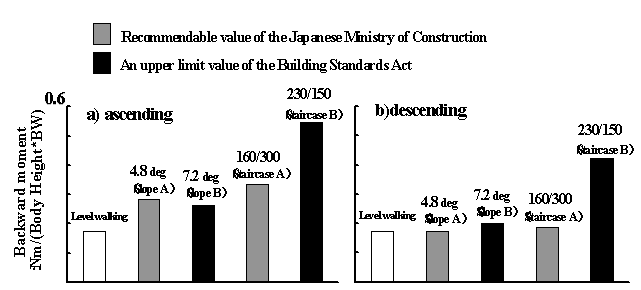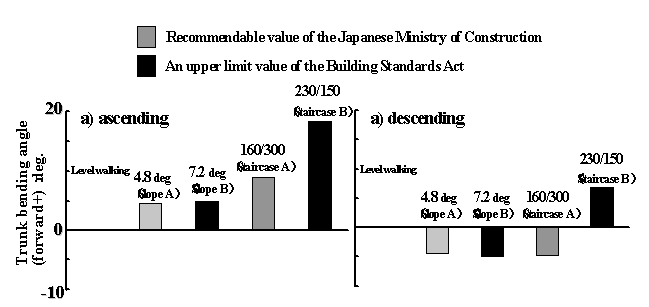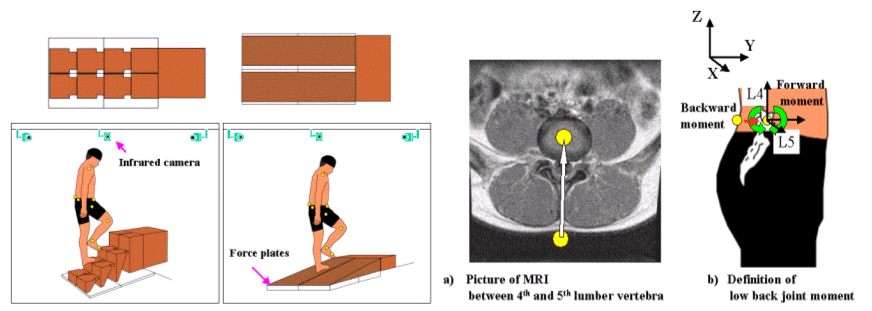LOW BACK JOINT MOMENT DURING ACSENDING AND DESCENDING STAIRS AND SLOPES
ABSTRACT
The purpose of this study was to investigate low back joint moment during ascending and ascending stairs and slopes of several dimensions and find the effect on these equipments on the low back joint moment. Selecting methods to modify the height of step usually found at the front doors for the elder people in Japan. Ascending and descending movements cause severe load to the low back but there is no objective criteria to select method to modify the height of step. Low back joint moment was obtained by inverse dynamics using data obtained by force plates and three dimensional motion analysis system. The stairs of 230/150 and 160/300 and the slope of 7.2deg and 4.8deg were used. The peak values of low back joint moment were detected and compared.
BACKGROUND
Nowadays, population of the elderly has increased tremendously in recent years and modification of houses for elder and disable people has also been on the increase in Japan. Putting grab bars at toilets and adjusting the height of the doorsteps are major modification methods being advocated for, but there is no objective evidence for them because most of these modifications have been based on experience of architects or subjectivity of users. Possible methods for negotiating the gaps are construction of stairs, a slope, or a small elevator. The former two are currently the most popular in Japan. If we take into consideration the progress of patients' disability and usage of wheelchairs posterity, it would be better to construct the slope in the front doors, but it is alleged that the slope is not appropriate for patient with conditions like Parkinson's disease or the low back pain. We can attribute inappropriateness of the slope to people with Parkinson's disease, to their acceleration-walking syndrome. However the reason why the slope is not suitable for patients with low back pain has not been clarified.
Although there have been a lot of studies about biomechanics during ascending and descending stairs (1), there are very few about the slopes (2). Also there are some studies, which investigated the low back joint moment during level walking (3), but there is no study that has investigated the low back joint moment during ascending and descending stairs and the slope.
RESEARCH QUESTION
The purpose of this study was to show the effects of methods of modifications used to vary the height of doorsteps and their dimensions on the low back load. We investigated the low back joint moment as low back load during ascending and descending stairs and the slope using force plates and three-dimensional motion analysis system.
METHOD
This study was performed on five healthy men with mean age of 22±4.8 years. Their mean height was 171.2±3.7cm and mean weight was 64±7.7Kg. The experimental set-up is shown in Fig.1. Floor reaction force during ascending and descending stairs and the slope was measured by 4 force plates (Kistler, Switzerland). Stairs and the slopes were put on each side of the force plates; the floor reaction force of both feet during ascending and descending was measured separately in this way. Three-dimensional motion analysis system VICON512 (Vicon Motion Systems, England) and eight infrared cameras were used to capture motion data in 120 Hz frequency. We attached fifteen reflective markers (25mm diameter) on both sides of the acromion process, the hip, anterior and posterior superior iliac spine, the knee, the ankle, and the 5th MP joints and the point between 4th and 5th lumber. Method of calculating the low back joint moment is shown in Fig.2. To measure the length from the marker put at the point between 4th and 5th lumber to center of vertebral body, we took an axial picture between 4th and 5th lumber vertebra using MRI, Signa Profile GE medicals USA. We interpolated that marker to the real center point of vertebral body using that MRI data and made link segment model to calculate the low back joint moment using inverse kinematics. In this study, it was assumed that the low back joint moment about X axis represents low back load. Dimension of the stairs and the slopes are listed in Table.1. These staircases and slopes were constructed according to recommended values of the Japanese Ministry of Construction and upper limit values of the Building Standards Act respectively.
RESULTS
The low back joint moment showed the peak values during the double stance phase of ascending and descending stairs and slopes. The means of peak values of the low back joint moment of five subjects during one gait cycle are shown in Fig.3. These data were normalized by subjects' height and weight. The data during ascending is shown in Fig.3a), and the data during descending is shown in Fig.3b). White bars show the peak value during level walking, and gray bars show the peak value using staircase A and slope A (recommended values of the Japanese Ministry of Construction), black bars show the peak values using staircase B and slope B upper limit values of the Building Standards Act in Japan). The backward low back joint moment during ascending stairs showed larger value than that of slopes. The backward low back joint moment during ascending staircase B was the largest and was three times of that exerted during level walking. Also the low back joint moment during descending staircase B showed larger backward moment than that of descending the slopes. The moment during descending staircase A and slopes showed similar value as that exhibited during level walking.
The means of peak values of trunk bending angle of five subjects are shown in Fig.4. The forward trunk bending angle during ascending stairs showed larger value than that of slope. The forward trunk bending angle during ascending staircase B was the largest. Meanwhile, the trunk bend backward during descending staircase A and slopes, and it bent forward only during descending staircase B.
| Stairs | Riser/Tread [mm] |
|---|---|
| Staircase A | 160/300 |
| Staircase B | 230/150 |
| Slope | Angle [deg.] |
| A | 4.8 |
| B | 7.2 |
DISCUSSION
Statically, the backward low back joint moment becomes larger with the amount of the forward trunk bending angle. Dynamically, it becomes larger with the amount of anterior component of inertia applied to trunk. Taking these things into consideration, we compared ascending stairs with slopes. Macfadyen et al. showed that concentric contraction of knee extensors and the triceps surae muscle mainly raise the body mass upward rather than forward during ascending stairs (1). Therefore inertial force applied to the trunk during ascending stairs was smaller than that of the slopes. However trunk forward bending angle during ascending stairs showed larger value than that of the slopes. Ascending staircase B showed the largest value and the effect of the trunk-bending angle was more dominant than inertial force. Consequently the low back joint moment during ascending stairs of both cases became larger than that during ascending slopes and also became largest during ascending staircase B. The trunk bent backward during descending staircase A and slopes to absorb the anterior inertial force applied to the trunk, i.e., the trunk bent in the opposite direction to increase the backward low back joint moment. Accordingly the backward low back joint moment during descending staircase A and slopes showed approximately same small value as that of level walking. However the trunk bent forward during descending staircase B to put the heel on the tread because the tread of this stairs was narrow, hence low back joint moment also showed large value during descending.
From these results, it was found that the dimensions of stairs and slopes had distinct effect on low back joint moment and it was more remarkable during ascending stairs. This result also revealed that using dimensions like those of staircase B required a large low back load and we can conclude that these types of stairs are inappropriate for the elderly and people with low back pain.
 |
 |
ACKNOWLEDGMENTS
This research funded by Sasagawa Scientific Research Grant from The Japan Science Society
Junji
Katsuhira
International University of Health and Welfare
2600-1 Kitakanemaru,
Ohtawara city, Tochgi 324-8501, Japan
+81-287-24-3161, katsuhir@iuhw.ac.jp

